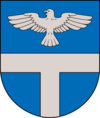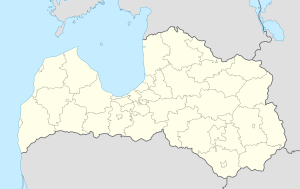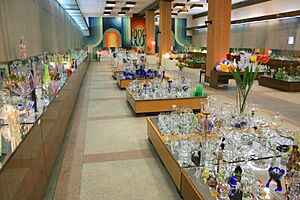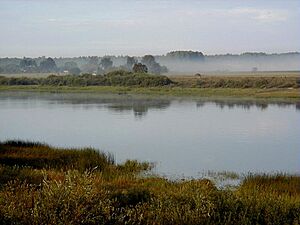Līvāni facts for kids
Quick facts for kids
Līvāni
|
|||
|---|---|---|---|
|
Town
|
|||
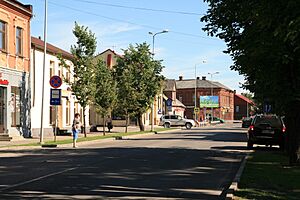
One of the streets in the centre of Līvāni
|
|||
|
|||
| Country | |||
| Municipality | Līvāni Municipality | ||
| Town rights | 1926 | ||
| Area | |||
| • Total | Lua error in Module:Wd at line 1,575: attempt to index field 'wikibase' (a nil value). km2 (Formatting error: invalid input when rounding sq mi) | ||
| • Land | Lua error in Module:Wd at line 1,575: attempt to index field 'wikibase' (a nil value). km2 (Formatting error: invalid input when rounding sq mi) | ||
| • Water | Expression error: Unexpected < operator. km2 (Formatting error: invalid input when rounding sq mi) | ||
| Population
(2024)
|
|||
| • Total | 6,790 | ||
| Time zone | UTC+2 (EET) | ||
| • Summer (DST) | UTC+3 (EEST) | ||
| Postal code |
LV-5316
|
||
| Calling code | +371 653 | ||
| Number of city council members | 11 | ||
| Website | http://www.livani.lv/ | ||
Līvāni is a town in eastern Latvia. It is located where the Dubna and Daugava rivers meet. Līvāni is about 170 kilometers east of Riga, Latvia's capital city.
Līvāni is an important town in the Latgale region. It connects roads to big cities like Riga and Daugavpils. It also links to neighboring countries like Russia, Belarus, and Lithuania. Since 2007, Līvāni has been a special center for growth and development in its region. The town has kept its historical charm while also adding modern touches. You can see this in the design of its streets, renovated buildings, and bike paths.
Contents
A Look Back: Līvāni's History
Līvāni's story began around 1533. A local landlord named Lieven built a manor and called it Lievenhof, after himself. In 1678, the first Catholic church was built here. The town faced many challenges during the two World Wars.
Long before that, in the 11th century, a settlement of traders and craftspeople existed here. It was part of the ancient Latgallian city-state of Jersika. This settlement was close to where the Dubna and Daugava rivers meet. The first written record of a fortified settlement called Dubna dates back to 1289.
In 1677, Līvāni became the property of a Polish nobleman, Leonard Pociej. He was Catholic and built the first Catholic church in 1678. This church was near the Dubna river. People used to call a nearby area "Beggar Bay" because beggars would gather there for food. Today, it is a nice place to live.
In 1824, Līvāni officially became a borough, which is a small town. The second folk-school in Latgale was opened here in 1854. A local pharmacy also opened in 1689. When Latvia became an independent country, Līvāni grew even more. It gained the legal status of a town in 1926.
About 370 wooden houses were built along the main street, Rīgas iela. This street became famous for its many small shops, often owned by local Jewish families. By the mid-1930s, Līvāni had around 180 shops. The town also became an important cultural center for the region.
Līvāni's Industrial Past
Līvāni has a special industrial history. For almost two centuries, industry helped the town grow. The economy got a big boost when the Riga-Orel railroad opened in 1861. Changes like ending serfdom in the 1860s also helped.
The town had good transport links by road and river. It also had cheap workers and many natural resources. There was plenty of wood nearby and more brought by the Dubna and Daugava rivers. Large amounts of clay, dolomite, sand, and peat were available. These materials were used to make building supplies, glass, and peat products.
By the early 1920s, Līvāni had 10 new factories. The biggest ones included a pulp plant (1872), a glass factory (1887), and a wood-processing plant. There were also factories making linoleum, bricks, and textiles. In Meņķi, across the Daugava river, a French company built a unique horn factory. It made buttons for clothes and telephones. This factory was the only one of its kind in Europe.
During World War I, Līvāni's factories closed. Their equipment was moved to Russia. For two and a half years, Līvāni was in the war zone. Constant fighting destroyed about 155 buildings. After the war, only 1880 people lived in Līvāni.
Business in Līvāni struggled during World War II. Half of the town was ruined. The Soviet occupation also caused changes. Old buildings and the natural beauty along the rivers were slowly lost. In the 1970s, new 5-story buildings replaced demolished houses.
This was also when large factories were built in Līvāni. In the 1970s and 1980s, a new biochemical plant was created. A construction materials factory and a building company also opened. The building company was famous for making "Līvāni houses," which were very popular in the 1980s. The old glass factory also grew. Līvāni became the third largest industrial center in Latgale, after Daugavpils and Rēzekne.
How Līvāni is Organized
Līvāni is a "linear town." This means it stretches out along the Daugava river and the main road/railroad from Riga to Daugavpils. This main route, Rīgas iela, is the central street of Līvāni. Most important services are found along this street. So, the town has one main center, but it doesn't have clear boundaries.
Two main roads cross Līvāni: national highway A6 (Riga - Daugavpils) and motorway P63 (Līvāni - Preiļi). In 2003, the bridge over the Dubna river and Riga street were rebuilt. They are now in good condition. The street lights in Līvāni have also been much improved recently.
Līvāni has 38.5 kilometers of roads and streets. About 84% of them are covered with asphalt. The other roads are covered with broken stones. Local businesses are happy with how the municipal roads are maintained.
A 4.8-kilometer long railway segment also crosses the town. The local train station handles cargo and passenger trains. It also provides transport services for local businesses. The station has five rail tracks, including one main line. In recent years, the local railroads have become very busy. About 48 cargo trains and 12 passenger trains pass through Līvāni station daily. To help with traffic, the Līvāni District Council plans to build a two-level rail crossing.
During summer, a ferry connects the two sides of the Daugava river. This ferry goes from Līvāni to Dignāja. It's the most direct way from Latgale to Zemgale. This ferry is important for people, cars, and cyclists living on both sides of the Daugava.
Images for kids
See also
 In Spanish: Līvāni para niños
In Spanish: Līvāni para niños



